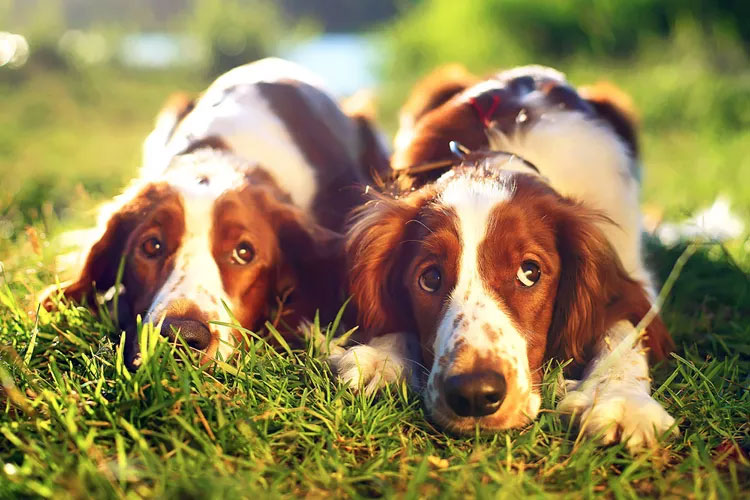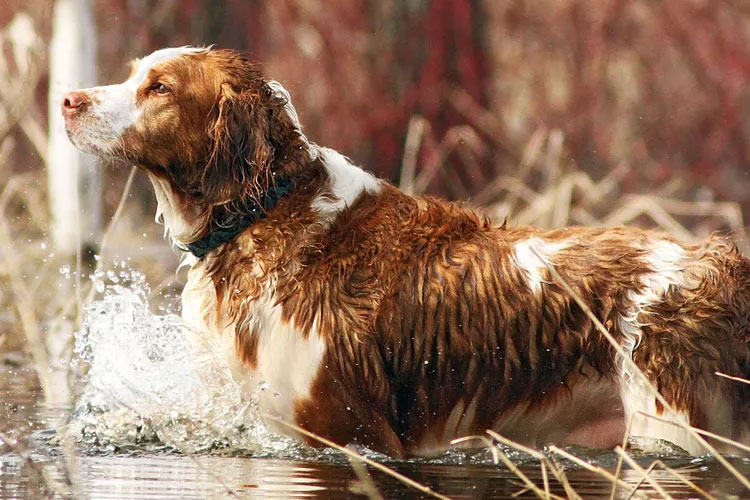Welsh springer spaniels are highly affectionate and intelligent dogs with rich red and white coats. Learn more about living with this happy family dog.

Welsh Springer Spaniel Overview
| OFFICIAL NAME | Welsh Springer Spaniel |
| COMMON NAME | Welsh Springer Spaniel |
| PET HEIGHT | 17 to 19 inches |
| PET WEIGHT | 35 to 55 pounds |
| LIFESPAN | 12 to 15 years |
| GOOD WITH | cats, children, dogs, families, seniors |
| TEMPERAMENT | aloof, gentle, playful |
| INTELLIGENCE | high |
| SHEDDING AMOUNT | normal |
| EXERCISE NEEDS | high |
| ENERGY LEVEL | active |
| VOCAL LEVEL | when necessary |
| DROOL AMOUNT | low |
| BREED GROUP | sporting |
| BREED SIZE | medium (26-60 lbs.) |
| COAT LENGTH | medium |
| COLORS | red, white |
| PATTERNS | bicolor |
| OTHER TRAITS | easy to groom, easy to train, good for first-time pet owners, good hiking companion, loves water, strong loyalty tendencies |
Once bred to be versatile hunting dogs in Great Britain, Welsh springer spaniels are now making themselves right at home as adaptable, loyal companion animals across the U.S.
These stunning red-and-white-coated dogs are incredibly affectionate with their human family members, especially toward children, which makes them a great fit for families big and small. They're also highly energetic and have an up-for-anything attitude that makes them ideal running and hiking buddies. These good-natured pups are also very intelligent, which can make positive reinforcement training a breeze.
Appearance
Welsh springer spaniels have a striking (and adorable!) appearance, thanks to their distinctive coats. This breed only comes in one color combination—red and white—but the colors come in lots of different patterns; the white areas of their fur are also sometimes flecked with red, too. Their weatherproof coat is typically medium in length, mostly straight, and very soft. The fur tends to feather out on the back of their legs, on their chest, and across the underside of their body.Gorgeous coat aside, these medium-sized dogs stand 17–19 inches tall and weigh 35–55 pounds. Males tend to be slightly larger than females.

Welshies have dark brown oval eyes that tend to have a soft, loving expression. Their mid-length ears hang down the sides of their head and may also have feathered hair on them. Welsh springer spaniels usually have black or dark brown noses.
Temperament
Welsh springer spaniels have earned a cute nickname over the years: Velcro dog. This stems from their total and unequivocal adoration of their human owners, according to the Welsh Springer Spaniel Club of America (WSSCA). They love nothing more than to follow their owners around all day, serving as their "shadow.""They are very devoted, loving dogs who will not leave your side," says Laura Robinson, DVM, veterinary advisor for Pawp.
Welshies are affectionate, fun-loving, and energetic dogs who are always ready for an adventure. Originally developed for hunting, these bird dogs love to stay active and use their top-notch sniffers to explore every nook and cranny wherever they are.
Welsh springer spaniels may be slightly reserved when meeting strangers for the first time, so owners should take care to socialize them from a young age and praise them during positive interactions with new people.
Living Needs
These playful, high-energy dogs need lots of regular exercise, whether that's walking, hiking, running, swimming, playing with toys, or participating in doggy sporting events. Some Welsh springer spaniels may love playing fetch, too.
Because of this, Welsh springer spaniels are happiest when they have a big, fenced-in backyard to romp around in on a daily basis. But with a commitment to daily walks and playtime, they can also happily live in apartments, condos, townhomes, and other small spaces—the amount of exercise an owner can provide is the key here. These dogs also thrive in performance events and activities like agility, obedience, rally, and tracking.
"Though the Welsh springer spaniel can make an excellent family pet, they do best with active families who live an outdoor lifestyle," says Jen Jones, a professional dog trainer and behavior specialist who runs Your Dog Advisor. "They would not make a great choice for a busy family or an older couple who don't have a lot of time to spend on their training and exercise."
They play well with other dogs, particularly when your Welsh springer spaniel puppy has been well-socialized, so they're a good fit for families who already have or plan to adopt other pups in the future.
These dogs can get along well with cats, especially when they're around kitties in puppyhood. That being said, this breed has a high prey drive thanks to their history as hunters, so they're not the best fit for families who keep other small mammals as pets. And each individual dog is different, so owners should take care when introducing Welshies to new cats, too.
One of the most notable Welsh springer spaniel characteristics is her gentleness with kids. These lovey-dovey dogs are incredibly affectionate toward children of all ages, though parents should always supervise interactions between all dogs and very young children. Welsh springer spaniels make a perfect addition to growing families and can provide warm, loving companionship to little ones (depending on the individual's dog temperament, of course).
Though they can tolerate being left alone, Welsh springer spaniels really prefer to be with their human companions as much as possible. They're called "Velcro dogs" for a reason, after all!
"Families that have to leave the house frequently may want to consider asking a pet sitter, daycare, or family friend to offer companionship to their Welshie while away from home," says Kim Archer, a dog trainer with Courteous Canine, Inc. in Florida.

Once they're worn out from exercising, playing, training, or some other form of stimulation (like a puzzle toy or game), Welshies are content to snuggle on the couch or curl up on the floor to nap near your feet.
Because they are so eager to please their human owners, Welsh springer spaniels can be easy to train, especially when they're rewarded with yummy treats, ear scratches, praise, or toys. This positive reinforcement helps them clearly and easily understand the behaviors you want them to perform! Welsh springer spaniel puppies also thrive in kindergarten training classes, too.
Set yourself up for success by keeping training sessions short and engaging. For best results, determine what your dog considers to be the ultimate reward—in the case of a Welshie, it's likely high-value treats, says Sarah Wooten, DVM, veterinary expert for Pumpkin Pet Insurance.
Care
Grooming a Welsh springer spaniel is a breeze, thanks to her low-maintenance coat. Owners should brush their Welsh springer spaniel once a week to keep her fur shiny and free from debris and tangles (a metal comb or a special slicker brush can help work through any tricky spots). Regular brushing will help keep shedding under control, too.To keep Welsh springer spaniels looking (and smelling) their best, owners should give them a bath roughly once a month, though the bathing schedule may vary depending on each dog's cleanliness levels. Owners can also help promote fresh breath and healthy, pearly whites by brushing their Welshie's teeth each night before bed and scheduling regular teeth cleanings by a veterinarian.
Because Welsh springer spaniels are so active and love to spend time outdoors in nature, it's also important to clean their ears regularly to help prevent any dirt and bacteria from building up. Their nails also benefit from periodically trimming using a grinder or clippers (a groomer can help with this, too!).
Health
With a proper diet, routine exercise, and regular visits to the veterinarian, these dogs make great family companions for the long haul—an average Welsh springer spaniel's life expectancy ranges between 12–15 years. These dogs are generally healthy and happy, though some may be susceptible to certain health issues.Responsible Welsh springer spaniel breeders perform hip and elbow evaluations, eye evaluations, and thyroid evaluations to screen for conditions such as elbow dysplasia and hip dysplasia, eye diseases, and autoimmune thyroiditis.
Welsh springer spaniels should receive all of the veterinarian-recommended vaccinations when they are puppies. Owners should keep those vaccinations up to date as the pup ages, following the prescribed schedule for each vaccine.
A veterinarian can also help determine the right type and amount of food for each individual Welsh springer spaniel, whose needs will vary depending on her size, activity level, and other factors. With regular exercise and proper nutrition, she should easily stay at a healthy weight.
History
Welshies are one of Britain's oldest dog breeds, reportedly dating back to 7000 BC. They were bred to help flush out, or "spring," animals and birds so that hunters could capture their game in a net or shoot it out of the air, according to the WSSCA. The impressive sniffing power of their noses and their rugged, semi-webbed feet also made them great hunting partners, whether on the ground or in water.The United Kennel Club recognized the breed in 1902, followed by the American Kennel Club in 1914.
Fun Facts
What's the difference between a Welsh springer spaniel vs. an English springer spaniel? These two dogs are closely related but distinctive breeds. Welsh springer spaniels tend to be slightly smaller than English springer spaniels. Welshies also have uniquely shaped heads with straighter muzzles and more domed skulls than other spaniels.Though no one has developed a miniature Welsh springer spaniel yet, this breed is believed to be related to the cocker spaniel, which is smaller when compared to Welsh springer spaniels. Cocker spaniels weigh between 20–30 pounds and stand 13.5–15.5 inches tall.